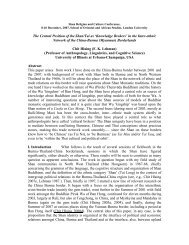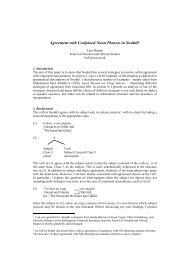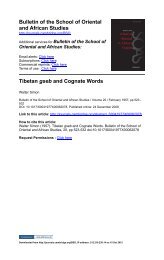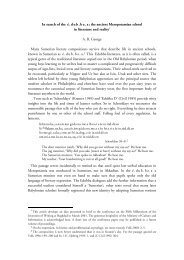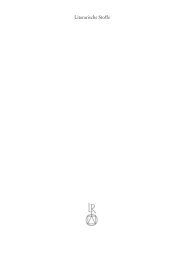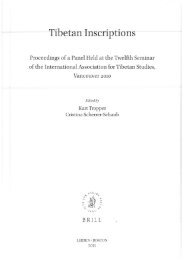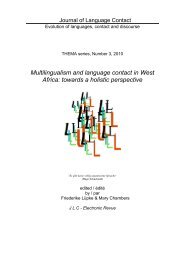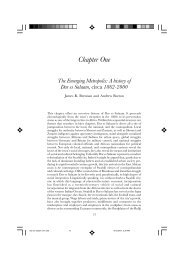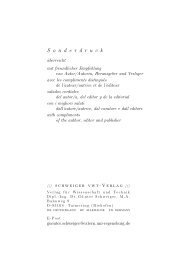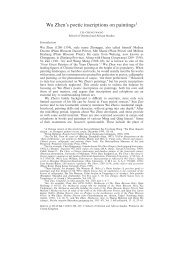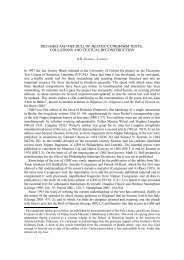Download (549Kb) - SOAS Research Online
Download (549Kb) - SOAS Research Online
Download (549Kb) - SOAS Research Online
Create successful ePaper yourself
Turn your PDF publications into a flip-book with our unique Google optimized e-Paper software.
76 Warfare and Poetry in the Middle East<br />
Some works of Hittite literature are apparently embedded as narratives<br />
into ritual or festival performance. The numerous myths recounting the<br />
tales of disappearing gods, especially that of Telipinu, son of the stormgod,<br />
frequently contain ritual episodes which doubtless replicate or parallel<br />
procedures of analogical magic performed in real time and designed<br />
to secure the return of fertility to the land. 11 By contrast, the narrative of<br />
the battle of the storm-god against the serpent Illuyanka is told in two<br />
different versions on one tablet as an aetiology for a spring festival at<br />
a particular location in Anatolia, and depicts a victory of the forces of<br />
order over chaos, although by using underhand and despicable means. 12<br />
Trickery, abuse of hospitality and a cold disregard for the value of human<br />
life on the side of the gods feature as themes in this tale.<br />
Some ritual texts contain elements of dialogue performed by participants,<br />
and one is left to wonder whether the immediate context of some<br />
of the mythological and even historical tales, which frequently contain<br />
significant sections of direct speech, might not have been performative,<br />
although this is currently not verifiable. 13 The step to the Greek tragedies,<br />
which were performed at the festival of Dionysus in Athens hundreds of<br />
years later, would not be so great. We must be careful, however, not to<br />
let our imaginations create contexts that are not clearly indicated by the<br />
textual and archaeological evidence.<br />
One group of texts conspicuous by its absence from the Hattusa archives<br />
is that of private economic documents. 14 These are well represented in<br />
other collections from the Ancient Near East, including from centres in<br />
Syria. The disparity observable at Hattusa may lead one to think that<br />
cuneiform was almost exclusively associated with the interests of the ruling<br />
class centred around the extended royal family and its bureaucracy. 15 This<br />
sociological observation has clear ramifications for the study of Hittite<br />
written culture. The audience of the texts we read will doubtless have been<br />
restricted. If the texts are at some distance reflections of more widespread<br />
oral traditions, which many of them surely are, these are something to<br />
which we can have no access.<br />
THE HITTITES AND MARTIAL POETRY FROM ABROAD<br />
It has proved extremely difficult to identify poetry in Hittite texts. Contrary<br />
to the Babylonians, but in keeping with the practice of cuneiform writing<br />
in Syria, the Hittites did not divide lines of poetic text into lines of written<br />
text on a clay tablet. This applies not only to texts written in Hittite, but<br />
03_Warfare&Poetry_Ch3_073-098.indd 76 06/02/2013 10:15



